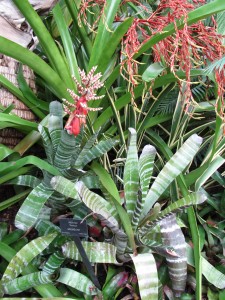The bromeliad plant family (Bromeliaceae) includes over 2000 species which live in tropical areas. This includes the pineapple. Bromeliads make great indoor plants. Leaves and flowers come in a wide variety of colors. They are easy to care for and will live for several years. They have very few pest problems.
Some bromeliads are epiphytes which live in trees and not soil. In the home epiphytic species grow on a piece of trunk bark or rough wood boards. Epiphytes have a weak rootsystem and grow poorly in soil. Epiphytes benefit from frequent misting. Terrestrial forms should be potted into a porous potting soil designated for house plants.
Plants thrive in high humid environment such as a greenhouse. Inside the home you should run a small room air humidifier near the plants or set them on a tray filled with gravel or pebbles. Keep gravel moist and do not submerge the base of the pot in water. Group plants together but do not crowd them to increase room humidity. Mist plants 1-2 times daily to raise the humidity around them.
Bromeliads prefer a well-lighted room or bright windowsill, away from direct sunlight. A south or east window is perfect. From late spring until early autumn, bromeliads flourish outdoors in a humid garden environment beneath a large shade tree, away from direct sunlight.
Bromeliads grow well in containers on shady porches and patios over the summer. Exposure to direct sunlight for an extended period of time may result in pale or chlorotic leaves. Poorly lighted plants appear weak or stretched.
They prefer temperatures between 55º F and 80º F, and should be brought indoors when temperatures dip below 40º F. You may water a bromeliad at the central cup, and never pour water soluble fertilizer in the cup. Bromeliads are low feeders, deriving some nitrogen from the air around them.
Water bromeliads once or twice weekly during the active spring, summer and early fall period and reduce watering frequency over winter when plants are mostly dormant. Overwatering is a common mistake.
Bromeliads flower only once and stop producing new leaves. Their brightly colored “flowers” are mostly bracts or modified leaves. Tiny flowers grow within these attractive bracts. The mother plant soon begins to die, but not before developing new young plants called “pups”. Pups grow at the base of the mother plant. Pups are detached from the mother plant, potted, and grown as an individual plant. Individual pups may take 2 years or more to reach flowering stage.


 Posted in
Posted in 
